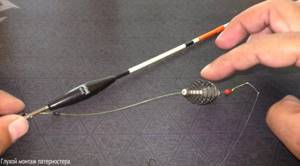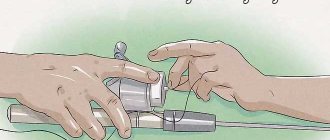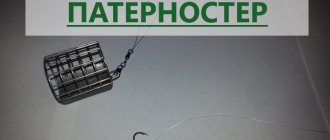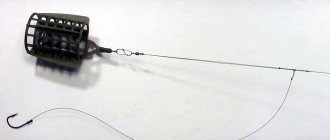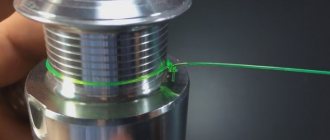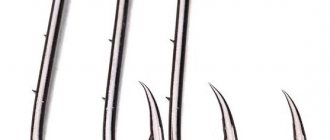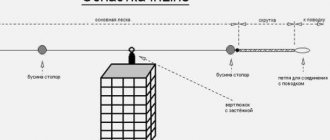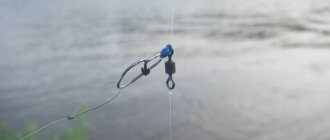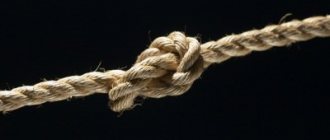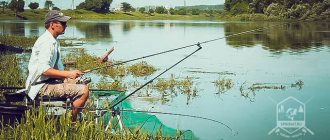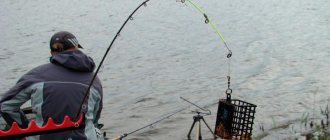What is an asymmetrical feeder loop
An asymmetrical loop for a feeder differs from a classic one in that one of its arms is about 10 cm longer than the other. The feeder is tied to the longer end of the asymmetrical equipment, which significantly increases the sensitivity of the feeder as a whole and transmits even the smallest vibrations of the hook or movements of the fishing line to the top of the rod.
Properties
It is recommended to tie an asymmetrical loop for the feeder for the following cases:
- catching small fish;
- fishing in still or pressed water;
- catching cautious or passive specimens.
Asymmetric feeder loop
When using this equipment, the fish does not feel the resistance of the fishing line for a long time, and this time is quite enough to plan and execute the hook.
Advantages and disadvantages
Reducing the size of one arm of a bulky and noticeable symmetrical loop turned it into an asymmetrical one, which does not oscillate in the water, is invisible to aquatic inhabitants and has a number of other advantages. This equipment for the feeder:
- allows the fish to swallow the bait deeper;
- helps to clearly feel the bite;
- hooks the catch more reliably even in strong currents;
- less susceptible to vibrations from rain, wind or strong currents and does not transmit them to the bait;
- it is attached to the main line using a swivel, and therefore it does not twist, and the leash and feeder cannot get mixed up, unlike inline;
- the lower unit is not injured and does not hit the swivel of the feeder, the tackle does not need to add extra stoppers or beads.
A tangible advantage of asymmetrical equipment is that the long fishing line is invisible to the fish, which will calmly catch the bait without feeling any danger.

The main disadvantage of the “asymmetrical” is that, unlike the Gardner equipment, installation of an asymmetrical loop is a complex and lengthy process that is difficult to carry out in the field and it is better to prepare the equipment at home in advance. Besides:
- novice fishermen may get confused by long leashes;
- You cannot use an asymmetrical loop when fishing in overgrown muddy reservoirs;
- auxiliary equipment is required.
When using asymmetrical gear, the catch does not catch itself and you need to constantly monitor the bite in order to have time to hook the fish.
What is the most important benefit of using an asymmetrical hinge?
Increased bite sensitivity
0%
Fishing even in strong currents
0%
The fish feels safe and swallows the bait deeper
0%
Feeder and leash do not get tangled
0%
The method is suitable for passive fish
0%
Voted: 0
Some subtleties
- For an asymmetrical loop, you must use a stiff line. You can check this by winding several turns around your finger. A suitable thread will straighten out immediately, but a thread that is too soft will retain its twisted shape.
- A good solution for this equipment would be fluorocarbon. You can read about its properties here. In addition to its rigidity, it is resistant to abrasion and is suitable for fishing on shell bottoms, on pebbles, near snags, and retains its properties when fishing on sharp edges and dumps.
- The length of the asymmetrical loop depends on the activity of the fish. The larger it is, the longer the feeder slides along the fishing line and the fish does not feel resistance. This is true for sluggish biting. With more active behavior of underwater inhabitants, the size of the equipment can be reduced.
- The twist length plays an important role in rigging. Too large will lead to frequent overlaps and tangling of the leash. A rigid, thick fishing line prevents this and behaves well even in the current.
- Typically, the length of the twist varies between 10–20 cm, but on a thin monofilament thread, about 0.20–0.25 mm, its size can be reduced to 6–8 cm. This will avoid frequent twisting of the leash.
- It is also necessary to say a few words about the length of the shoulder. It is accepted that its size should be 2 cm. If the overhang is made larger, the equipment will lose sensitivity and many careful bites will go unnoticed. If it is less, then the leash and the feeder will often get confused and overlap.
- After the asymmetrical loop is knitted, all that remains is to pick up the leashes. Their choice depends on the activity of the fish and fishing conditions. The thickness of the fishing line used is 0.12–0.16 mm. In rare cases, when hunting for large fish, it is advisable to increase the diameter to 0.20 mm.
- The length of the leashes is adjusted to the mood of the underwater inhabitants. The more apathetic and passive the fish, the larger their size should be. When biting is active, it is advisable to shorten them.
How to use
After casting, you need to wait until the feeder touches the bottom and pull the cord so that it moves to the bottom point of the loop. After the bite, the fish moves with the bait in its mouth along the fishing line, not noticing resistance. The fisherman, in turn, notices all the pulls and has enough time to prepare and make the hook.
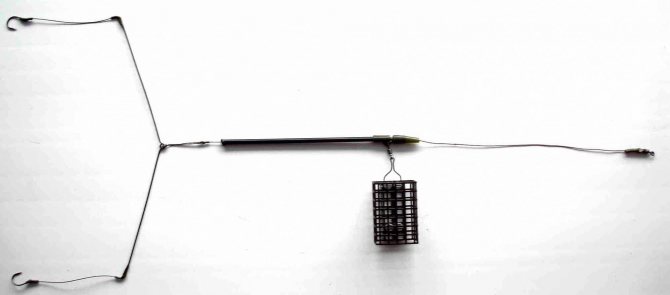
How to use an asymmetrical loop
If the installation of the asymmetrical loop for the feeder was carried out correctly, then the same tackle can be used for 2-4 active fishing trips. But even perfectly tied gear can be damaged during fishing. In case the line breaks or is cut, you should always have several ready-made loops in stock. The equipment should be stored in a small cellophane bag or a special box, which can be bought at a fishing equipment store.
How to knit
It is better to knit an asymmetrical loop for a feeder at home, carefully and slowly, because when creating it, the length of the arms, the size of the twist, and the quality of the knots are important.
Installation diagram
Step-by-step installation of an asymmetrical loop for a feeder:
- A piece of fishing line about a meter long is folded in half.
- Using a double knot or a figure-of-eight knot, twist part of the tackle into a small ring, onto which the leash will subsequently be attached.
- A twist 10-15 cm long is removed from the resulting circle and secured using a similar knot.
- A swivel with a fastener is put into the fishing line so that the twist is on the side, 5-7 cm from it.
- Measure a loop 15-20 centimeters long and tie a locking knot.
- The final knot connects the main line and the swivel to the clasp, as shown in the diagram below.
- The leash is also attached using a swivel.
After installation is complete, you should make sure that the feeder can move freely from the twist to the base, and cut off all excess ends of the fishing line so that it does not get tangled.
Knitting pattern for an asymmetrical loop for a feeder:

Knitting pattern
When the fish actively bites, the length of the asymmetrical loop for the feeder should be reduced, and in the case of passive biting, increased.
Shock absorber insert from feeder
A thin line is less noticeable even for cautious fish and is more sensitive to bites, but when catching a large specimen, such tackle can break. To prevent this unpleasant situation, they use a feedergam - a shock-absorbing insert made of elastic rubber, which reduces the load on the leash and compensates for sudden jerks of the “prey”.
Step-by-step lesson on using feedergam to strengthen asymmetrical equipment:
- Take a rope 8-12 cm long and tie loops at both ends using a figure-of-eight knot (the tackle should be taut during operation).
- Insert the feeder elastic into the place to which the leash will be tied, and secure it “loop to loop”.
- A leash is attached to the remaining free loop.
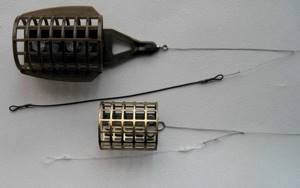
Shock absorber insert from feeder
Thanks to the installation of the feedergam, you can use any, even the thinnest leashes.
Nuances to consider
For successful fishing, it is not enough to learn how to knit an asymmetrical loop for a feeder; you need to take into account several more aspects:
- when casting, the equipment needs to be slightly pulled towards you, then the feeder will move to the edge of the fishing line after sinking to the bottom;
- It is best to fish with a feeder on a flat area of the bottom, so that the bait does not roll into the depressions and the hook is always inside the feeding cloud.
You need to use only high-quality elements. If the clasp breaks, it will be very difficult to replace it without ruining the loop.
Your question to an expert
Leonid Grachev
Fisherman with a lot of knowledge and experience
Ask a Question
Advantages and disadvantages
The asymmetrical feeder loop is one of the basic rigs that a beginner must master and learn to use in appropriate situations. Its advantages are as follows: • High sensitivity, allowing you to record the most careful and accurate bites. • Allows you to effectively fish in still waters using light feeders and thin leashes. • Suitable for passive fish. • Suitable for pressed-in reservoirs. An asymmetrical loop also has disadvantages that must be taken into account when choosing equipment for specific conditions. • some difficulty in knitting and installation; • the fish does not hook itself, which is inconvenient during active biting; • the presence of additional elements in the equipment, such as a fastener; • when using long leashes it can get confused, especially important for beginner feeders. As you can see, the choice of equipment depends on the specific fishing conditions. You should always experiment, select the optimal one, change the thickness of the fishing line and the length of the leashes, vary the weight of the feeder in order to get the maximum result.
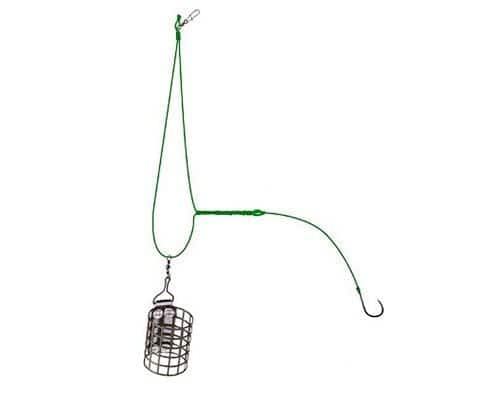
Which is better: installing a separate equipment or tying it on the main line
As a last resort, you can install an asymmetrical loop for the feeder on the main braided cord, but it is better to knit in this way only if absolutely necessary. Braided braid is less rigid than twisted line or fluorocarbon, and each installation will reduce the length of the main line, which is often expensive.
A rig with an asymmetrical loop is the most common feeder fishing method among fishermen. The explanation for this popularity is very simple: tackle with different arms helps to catch fish of any size, regardless of weather conditions or the strength of the current.
Paternoster
Paternoster is most often used for catching perch and other predatory fish.
How to install a paternoster with your own hands
Paternoster installation:
- At the end of the loop structure, secured with a triple knot, a leash with a hook is tied;
- a second larger design is knitted 10-15 cm higher;
- the feeder is attached to a large loop;
- The leash is attached using the cape method.
Anti-tangle paternoster
To avoid overlap and the tackle does not get tangled, a twist is added to the paternoster. It is performed after a small loop. Both ends of the cord are twisted and secured with a triple knot.
Blind installation of paternoster
Blind installation is the attachment of the feeder to the leash. Equipment installation procedure:
- at the end of the main thread a structure 25 cm long is formed;
- it is cut in half;
- A feeder and a leash are attached to the resulting segments.
